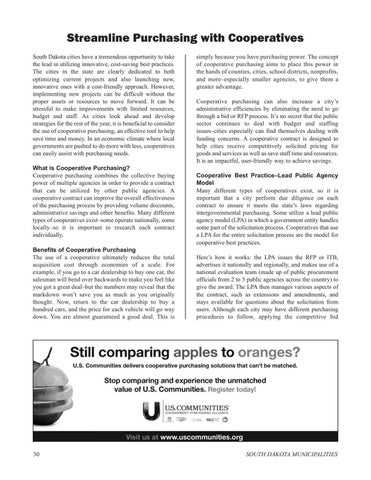Streamline Purchasing with Cooperatives South Dakota cities have a tremendous opportunity to take the lead in utilizing innovative, cost-saving best practices. The cities in the state are clearly dedicated to both optimizing current projects and also launching new, innovative ones with a cost-friendly approach. However, implementing new projects can be difficult without the proper assets or resources to move forward. It can be stressful to make improvements with limited resources, budget and staff. As cities look ahead and develop strategies for the rest of the year, it is beneficial to consider the use of cooperative purchasing, an effective tool to help save time and money. In an economic climate where local governments are pushed to do more with less, cooperatives can easily assist with purchasing needs. What is Cooperative Purchasing? Cooperative purchasing combines the collective buying power of multiple agencies in order to provide a contract that can be utilized by other public agencies. A cooperative contract can improve the overall effectiveness of the purchasing process by providing volume discounts, administrative savings and other benefits. Many different types of cooperatives exist–some operate nationally, some locally–so it is important to research each contract individually. Benefits of Cooperative Purchasing The use of a cooperative ultimately reduces the total acquisition cost through economies of a scale. For example, if you go to a car dealership to buy one car, the salesman will bend over backwards to make you feel like you got a great deal–but the numbers may reveal that the markdown won’t save you as much as you originally thought. Now, return to the car dealership to buy a hundred cars, and the price for each vehicle will go way down. You are almost guaranteed a good deal. This is
30
simply because you have purchasing power. The concept of cooperative purchasing aims to place this power in the hands of counties, cities, school districts, nonprofits, and more–especially smaller agencies, to give them a greater advantage. Cooperative purchasing can also increase a city’s administrative efficiencies by eliminating the need to go through a bid or RFP process. It’s no secret that the public sector continues to deal with budget and staffing issues–cities especially can find themselves dealing with funding concerns. A cooperative contract is designed to help cities receive competitively solicited pricing for goods and services as well as save staff time and resources. It is an impactful, user-friendly way to achieve savings. Cooperative Best Practice–Lead Public Agency Model Many different types of cooperatives exist, so it is important that a city perform due diligence on each contract to ensure it meets the state’s laws regarding intergovernmental purchasing. Some utilize a lead public agency model (LPA) in which a government entity handles some part of the solicitation process. Cooperatives that use a LPA for the entire solicitation process are the model for cooperative best practices. Here’s how it works: the LPA issues the RFP or ITB, advertises it nationally and regionally, and makes use of a national evaluation team (made up of public procurement officials from 2 to 5 public agencies across the country) to give the award. The LPA then manages various aspects of the contract, such as extensions and amendments, and stays available for questions about the solicitation from users. Although each city may have different purchasing procedures to follow, applying the competitive bid
SOUTH DAKOTA MUNICIPALITIES

















